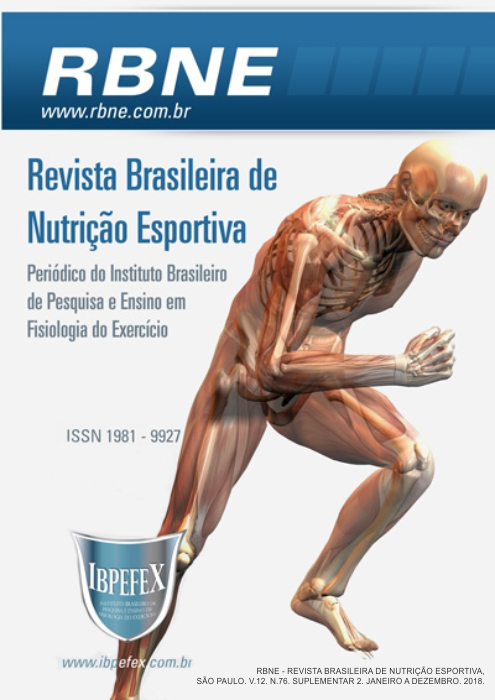Nutritional status evaluation and dietary intervention in American Football players in Petrolina-PE
Abstract
The performance and wad of the athletes can be improved when they change their nutrition. The diet, which consist all nutrients, can preserve body composition, supports the functioning of the metabolic pathways associated with the sporting modality. In view of the above, the present study aimed to analyze anthropometric indicators, guide and intervene in the food standard of the players. The sample consisted of 40 male athletes aged 23.79 ± 4.92 years. Measurements of height, weight, body mass index (BMI) and fat percentage (%G) estimated by bioelectrical impedance. The others measures were, the skin folds and perimeter of the arm, chest, waist, abdomen, hip, thigh and calf were measured, the food intake was evaluated using the 24-hour Dietary Recall (R24ec). No statistical difference was observed in the comparison between defense and attack groups, in weight, BMI and muscle mass. However, a statistical difference was observed in the percentage of fat between the attack groups (29.22 ± 8.47, n=10; p=0.0316). After the dieting intervention, there were no significant differences between the parameters for BMI, %G, %MM and SBP, of the athletes in the different positions of the team. Meanwhile there was a significant difference for diastolic pressure. The nutrition it is a factor that adds to performance in the field. The higher the body mass of fat, the lower the yield, as well as the greater the risk of cardiovascular diseases and bone fracture. Conclusion: The results taken together show the moderate risk of the players having future metabolic changes.
References
-Abbey, E.L.; Wright, C.J.; Kirkpatrick, C.M. Nutrition practices and knowledge among. NCAA Division III football players. Journal of the International Society of Sports Nutrition. Vol. 14. Num. 13. 2017. 2-9.
-Behnke, A.R.; Welham, W.C. The specific gravity of healthy men; body weight/volume and other physical characteristics of exceptional athletes and of naval personnel. Vol. 14. 1942. p. 498-499.
-Comachio, J.; Comachio, G.; Rietjens, P.; Lovato, M.; Perenci, J.; Favaro, O. Desempenho anaeróbio e características antropométricas de jogadores de futebol americano de uma equipe brasileira. Revista Brasileira de Prescrição e Fisiologia do Exercício. Vol. 9. Núm. 51. p. 72-80. 2015. Disponível em: <http://www.rbpfex.com.br/index.php/rbpfex/article/view/728>
-Condello, G.; Schultz, K.; Tessitore, A. Assessment of sprint and change-of-direction performance in College Football Players. International Journal of Sport Physiology and Performance. Vol. 8. 2013. p. 211-212.
-Coyle, E.F. Altos e baixos das dietas à base de carboidratos. Eports Science Exchange. Gatorade Sports Science Institute. Vol. 22. 2005. p. 2-5.
-Dietary Reference Intakes (DRIs): Estimated Average Requirements. S trengthening Knowledge and Understanding of Dietary Supplements. Food and Nutrition Board Institute of Medicine. 2011.
-Garstecki, M.A.; Latin, R.W.; Cuppet, M.M. Comparison of selected physical fitness and performance variables between NCAA Division I and II football players. Journal Strength and Conditioning Research. Vol. 18. Num. 2. 2004.
-Goodell, R. Official playing rules of the national football league. [S.l.: s.n.], 2017. 210 p.
-Kraemer W.J; Torine, J.C; Silestre, R; French, D.N; Ratamess, N.A; Spiering, B.A; Hatfield, D.L; Vingren, J.L; Volek, J.S. Body size and composition of National Football League players. Journal f oStrength and Conditioning Research. New Jersey. Vol. 19. Num. 3. 2005. p. 485-489.
-Lancha Junior, A.H. Nutrição e Metabolismo Aplicados à Atividade Motora. Revista Brasileira de Educação Física e Esporte. São Paulo. Vol. 25. Num. 5. 2011. p. 45-51.
-Lockie, R.G.; Schultz, A. B.; Callaghan, S. J.; Jeffriess, M. D. Physiological Profile of National: level Junior American Football Players Australia. Serbian Journal of Sport Sciences. Australia. Vol. 6. 2012.
-Mcardle, W.D.; Katch, I.F; Katch, V.L. Exercise physiology: nutrition, energy, and human performance. Sports Medicine. Philadelphia. Vol. 7. Num 2. 2010. p. 723-730.
-Pinto, S. I. F.; Berdacki, V. S.; Biesek, S. Avaliação da perda hídrica e do grau de conhecimento em hidratação de atletas de futebol americano. Revista Brasileira de Nutrição Esportiva, São Paulo. Vol. 8. Num. 45. 2014. p.171-179. Disponível em: <http://www.rbne.com.br/index.php/rbne/article/view/454>
-Scott, C.B.; Kemp, R.B. Direct and indirect calorimetry of lactate oxidation: implications for whole-body energy expenditure. Journal of Sports Sciences. London. Vol. 23. Num. 15. 2005. p. 15-19.
-Sociedade Brasileira De Medicina Do Esporte. Diretriz Oficial Atividade Física e Saúde. 2009.
-Vural, F.; Rudarli, N.G.; Ozkol, M.Z. Physical and Physiological status in American Football Players in Turkiye. Serbian Journal of Sports Sciences. Servia. Vol. 3. Num. 1. 2009. p. 9-17.
-Widmer, R.J.; Flammer, A.J.; Lerman, L.O.; Lerman, A. The Mediterranean diet, its components, and cardiovascular disease. American Journal of Medicine. Elsevier. Zurich. Vol. 128. Num. 3. 2015. p. 229-238.
Authors who publish in this journal agree to the following terms:
- Authors retain the copyright and grant the journal the right of first publication, with work simultaneously licensed under the Creative Commons Attribution License BY-NC which allows the sharing of the work with acknowledgment of the authorship of the work and initial publication in this journal.
- Authors are authorized to enter into additional contracts separately for non-exclusive distribution of the version of the work published in this journal (eg, publishing in institutional repository or book chapter), with acknowledgment of authorship and initial publication in this journal.
- Authors are allowed and encouraged to post and distribute their work online (eg, in institutional repositories or on their personal page) at any point before or during the editorial process, as this can bring about productive change as well as increase impact and impact. citation of published work (See The Effect of Free Access).






